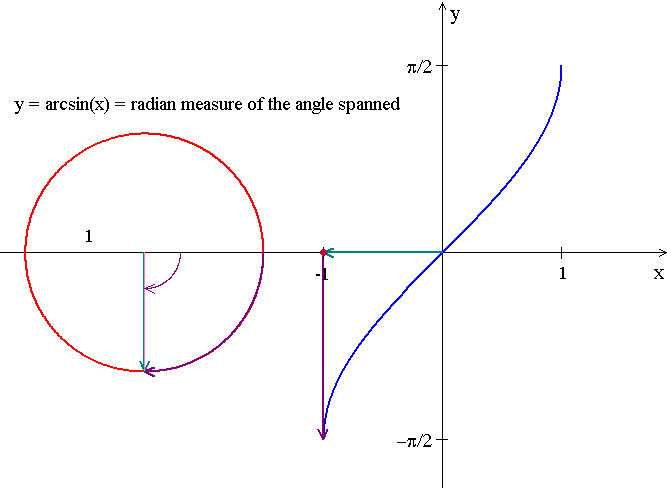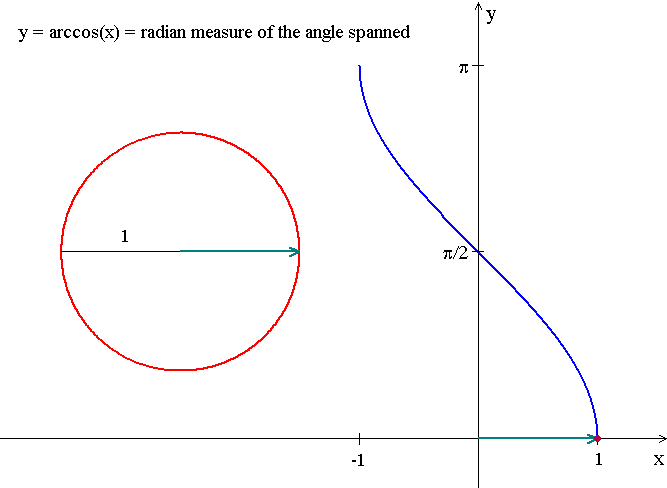

Look at how the \(y\)-coordinate of a point running along a unit circle varies as a function of circular arc length travelled!
Notation: \(y=\sin x\)
Domain: \(-\infty <x<\infty\), i.e., the set of all real numbers (radian measures of directed angles)
Range: \(-1\le y\le 1\), i.e., the interval \([-1,1]\)
Period = length of the unit circle = \(2\pi\)
An odd function: \(\sin(-x) = - \sin x\)
| \(x\) | \(0\) | \(\frac{\pi}{6}\) | \(\frac{\pi}{4}\) | \(\frac{\pi}{3}\) | \(\frac{\pi}{2}\) | \(\frac{2\pi}{3}\) | \(\frac{3\pi}{4}\) | \(\frac{5\pi}{6}\) | \(\pi\) |
| \(\sin x \) | \(0\) | \(\frac{1}{2}\) | \(\frac{\sqrt{2}}{2}\) | \(\frac{\sqrt{3}}{2}\) | \(1\) | \(\frac{\sqrt{3}}{2}\) | \(\frac{\sqrt{2}}{2}\) | \(\frac{1}{2}\) | \(0\) |
| \(x\) | \(-\pi\) | \(-\frac{5\pi}{6}\) | \(-\frac{3\pi}{4}\) | \(-\frac{3\pi}{2}\) | \(-\frac{\pi}{2}\) | \(-\frac{\pi}{3}\) | \(-\frac{\pi}{4}\) | \(-\frac{\pi}{6}\) | \(0\) |
| \(\sin x\) | \(0\) | \(-\frac{1}{2}\) | \(-\frac{\sqrt{2}}{2}\) | \(-\frac{\sqrt{3}}{2}\) | \(-1\) | \(-\frac{\sqrt{3}}{2}\) | \(-\frac{\sqrt{2}}{2}\) | \(-\frac{1}{2}\) | \(0\) |

Look at how the \(x\)-coordinate of a point running along a unit circle varies as a function of circular arc length travelled!
Notation: \(y=\cos x\)
Domain: \(-\infty <x<\infty\), i.e., the set of all real numbers (radian measures of directed angles)
Range: \(-1\le y\le 1\), i.e., the interval \([-1,1]\)
Period = length of the unit circle = \(2\pi\)
An even function: \(\cos(-x) = \cos x\)
| \(x\) | \(0\) | \(\frac{\pi}{6}\) | \(\frac{\pi}{4}\) | \(\frac{\pi}{3}\) | \(\frac{\pi}{2}\) | \(\frac{2\pi}{3}\) | \(\frac{3\pi}{4}\) | \(\frac{5\pi}{6}\) | \(\pi\) |
| \(\cos x\) | \(1\) | \(\frac{\sqrt{3}}{2}\) | \(\frac{\sqrt{2}}{2}\) | \(\frac{1}{2}\) | \(0\) | \(-\frac{1}{2}\) | \(-\frac{\sqrt{2}}{2}\) | \(\frac{\sqrt{3}}{2}\) | \(-1\) |
| \(x\) | \(-\pi\) | \(-\frac{5\pi}{6}\) | \(-\frac{3\pi}{4}\) | \(-\frac{3\pi}{2}\) | \(-\frac{\pi}{2}\) | \(-\frac{\pi}{3}\) | \(-\frac{\pi}{4}\) | \(-\frac{\pi}{6}\) | \(0\) |
| \(\cos x\) | \(-1\) | \(-\frac{\sqrt{3}}{2}\) | \(-\frac{\sqrt{2}}{2}\) | \(-\frac{1}{2}\) | \(0\) | \(\frac{1}{2}\) | \(\frac{\sqrt{2}}{2}\) | \(\frac{\sqrt{3}}{2}\) | \(1\) |
(ii) \(\cos(\frac{\pi}{2} - x) = \sin x\) . Why?
Note that \(\cos(A+B)=\cos A\cos B -\sin A\sin B\) if and only if \[\big(\cos(A+B)-1)^2+\sin^2(A+B) = \big(\cos A -\cos (-B)\big)^2+\big(\sin A -\sin (-B)\big)^2 \] where the left hand side is the distance between the points \((\cos(A+B),\sin (A+B))\) and \( (1,0)\), and the right hand side is the distance between the points \((\cos A,\sin A)\) and \((\cos (-B), \sin (-B))\).
(i) Now draw the points \((\cos A,\sin A)\), \((\cos (-B), \sin (-B))\) and \((\cos(A+B),\sin (A+B))\) on the unit circle centered at the orgin and see what this identity means.
(ii) Use this angle sum formula for consine to derive the other angle sum and angle difference formulas.

Domain: [-1, 1]
Range: [-Łk/2, Łk/2]

Domain: [-1, 1]
Range: [0, Łk]
Using suitable differentiation rules, e.g., quotient rule, chain rule or implicit differentiation, all these derivative formulas can be derived from the first one, i.e., \(\dfrac{d\sin x}{dx} = \cos x\).